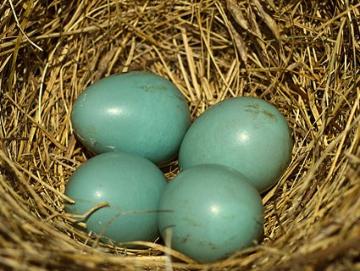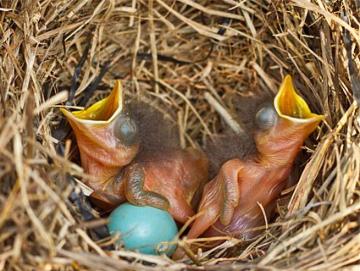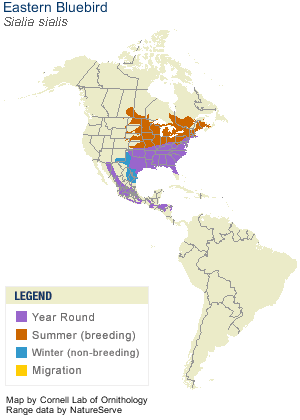 |
Canku Ota
|
 |
|
(Many Paths)
|
||
|
An Online Newsletter
Celebrating Native America
|
||
|
January 2016 - Volume
14 Number 1
|
||
|
|
||
|
Eastern Bluebird
Sialia sialis |
||
|
by Cornell Lab of Ornithology
|
||
Most of the country drives during an eastern North American summer will turn up a few Eastern Bluebirds sitting on telephone wires or perched atop a nest box, calling out in a short, wavering voice or abruptly dropping to the ground after an insect. Marvelous birds to capture in your binoculars, male Eastern Bluebirds are a brilliant royal blue on the back and head, and warm red-brown on the breast. Blue tinges in the wings and tail give the grayer females an elegant look
At a Glance
Cool Facts
Eastern Bluebirds live in open country around trees, but with little understory and sparse ground cover. Original habitats probably included open, frequently burned pine savannas, beaver ponds, mature but open woods, and forest openings. Today, they’re most common along pastures, agricultural fields, suburban parks, backyards, and golf courses.
Insects caught on the ground are a bluebird’s main food for much of the year. Major prey include caterpillars, beetles crickets, grasshoppers, and spiders. In fall and winter, bluebirds eat large amounts of fruit including mistletoe, sumac, blueberries, black cherry, tupelo, currants, wild holly, dogwood berries, hackberries, honeysuckle, bay, pokeweed, and juniper berries. Rarely, Eastern Bluebirds have been recorded eating salamanders, shrews, snakes, lizards, and tree frogs.
Nesting
Eastern Bluebirds put their nests in natural cavities or in nest boxes or other artificial refuges. Among available natural cavities, bluebirds typically select old woodpecker holes in dead pine or oak trees, up to 50 feet off the ground. Older bluebirds are more likely than younger ones to nest in a nest box, although individual birds often switch their preferences between nesting attempts. When given the choice in one study, bluebirds seemed to prefer snugger nest boxes (4 inches square instead of 6 inches square on the bottom) with slightly larger entrance holes (1.75 inch rather than 1.4 inch diameter). Eastern Bluebird Nest Image 1
This small, brightly colored thrush typically perches on wires
and fence posts overlooking open fields. The birds forage by fluttering
to the ground to grab an insect, or occasionally by catching an
insect in midair. Bluebirds can sight their tiny prey items from
60 feet or more away. They fly fairly low to the ground, and with
a fast but irregular pattern to their wingbeats. Males vying over
territories chase each other at high speed, sometimes grappling
with their feet, pulling at feathers with their beaks, and hitting
with their wings. The boxes and tree cavities where bluebirds nest
are a hot commodity among birds that require holes for nesting,
and male bluebirds will attack other species they deem a threat,
including House Sparrows, European Starlings, Tree Swallows, Great
Crested Flycatchers, Carolina Chickadees, and Brown-headed Nuthatches,
as well as non-cavity nesters such as robins, Blue Jays, mockingbirds,
and cowbirds. Males attract females to the nest with a display in
which he carries bits of nesting material into and out of the nest.
Once a female enters the nest hole with him, the pair bond is typically
established and often remains intact for several seasons (although
studies suggest that around one in every four or five eggs involves
a parent from outside the pair).
Eastern Bluebird populations increased by almost 2 percent per year between 1966 and 2010, according to the North American Breeding Bird Survey. Partners in Flight estimates the global breeding population at 22 million, with 86 percent spending part of the year in the U.S., 22 percent in Mexico, and 1 percent breeding in Canada. They rate a 7 out of 20 on the Continental Concern Score and they are not on the 2012 Watch List. Eastern Bluebird populations fell in the early twentieth century as aggressive introduced species such as European Starlings and House Sparrows made available nest holes increasingly difficult for bluebirds to hold on to. In the 1960s and 1970s establishment of bluebird trails and other nest box campaigns alleviated much of this competition, especially after people began using nest boxes designed to keep out the larger European Starling. Eastern Bluebird numbers have been recovering since. |
||||||||||||||||||||||||||||||||||||||||
|
|
|
||
|
|
||
| Canku Ota is a free Newsletter celebrating Native America, its traditions and accomplishments . We do not provide subscriber or visitor names to anyone. Some articles presented in Canku Ota may contain copyright material. We have received appropriate permissions for republishing any articles. Material appearing here is distributed without profit or monetary gain to those who have expressed an interest. This is in accordance with Title 17 U.S.C. Section 107. | ||
|
Canku Ota is a copyright ©
2000 - 2016 of Vicki Williams Barry and Paul Barry.
|
||
 |
 |
|
|
The "Canku
Ota - A Newsletter Celebrating Native America" web site and
its design is the
|
||
|
Copyright ©
1999 - 2016 of Paul C. Barry.
|
||
|
All Rights Reserved.
|
||








